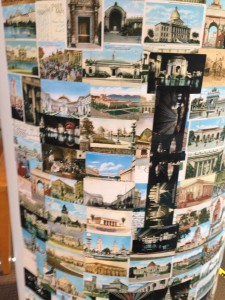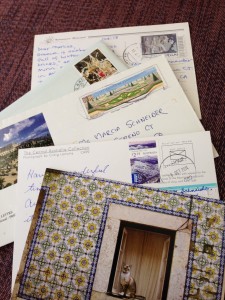
When did the postmark on our letters go missing? By postmark, I refer to the round circle that once included the date, time of receipt and location of the post office. Generally, the circle was stamped to the left of the cancellation, those wavy or straight lines that partially cover the stamp(s) to indicate that the stamp has been used. I was reminded of this absence recently by the marketing efforts of a certain coffee company promoting a new first edition blend, using a version of the classic circle.
Although our first class, stamped mail still includes the same information, the circle has been replaced with straight text, applied electronically along with the cancellation. Gone are the unique differences between cities, as the electronic stamp from the city of origin is now uniform and looks the same from city to city.
Postmarks, either handwritten or stamped, date back to the mid-17th century and perhaps earlier. Prepaid letter sheets were first sold in France in 1653. In England, Cromwell appointed Colonel Henry Bishop as postmaster general in 1661. An ordinance quickly followed that a stamp was to be stuck on all letters that included the date the letter was delivered to the post office. The stamp came to be known as “the Bishop mark,” and often included the weight of the envelope. Postage due notations were not uncommon, the cost to be charged to the recipient of the letter.
In the U.S., individual states, territories and posts issued their own postmarks, many of which do not relate to the towns and cities of today. For example, there was the state of Frankland, which would have been located in what we know today as northeastern Tennessee. The Territory of Jefferson encompassed parts of Kansas, Nebraska, Utah and New Mexico.
Although early Spanish colonists first reached what is now known as San Francisco in 1776, it was not until 1846 that Capt. John B. Montgomery proclaimed possession for the U.S. In 1847, General Stephen Kearny, military governor of California, named the settlement San Francisco and established the first official mail service by horseback along El Camino Real, reaching as far south as San Diego.
Hundreds of thousands of new settlers arrived in the late 19th century for the Gold Rush, the majority arriving by steamer. They brought with them thousands of letters, most often with limited information about the actual residence or location of the intended recipients. The first San Francisco post office was established in 1857 at the corner of Stockton and Washington. After a couple of interim relocations, the U.S. Post Office moved to 7th and Mission streets.
San Francisco alone had 17,000 documented postal markings between 1849 and 1935, in all shapes and dimensions, including circles, ovals, double circles, barred circles, double ovals and more. Colors added new dimensions, with each color and style representing different dates and rates. They might have been red, black, blue, or orange. A magenta marking in 1868 represented a stamp worth twenty -four cents.
Special markings also characterized the mail from the late 19th century to the early 20th century. Common messages were “returned for postage,” “returned to writer,” “could not be found,” “Dead Letter Office,” and “postage due.” With today’s technology and mail volume, none of this individualization would be cost effective. Uniformity leads to greater efficiency, but at what cost? Mail enthusiasts still love mail art, but now it is up to the sender, not the postal service, to apply interesting colorful markings and stamps.

For collectors, philatelists and nostalgists, I came across the Postmarks Collectors Club, an organization with worldwide membership founded in 1946. The Postmarks Collectors Club publishes a monthly bulletin with interesting historical articles, photos, auction news and more, and publishes complete lists of post offices within the U.S. and territories, as well as information about relocations and closures. The organization also holds an annual conference and is the sponsor of the National Postmark Museum in Lyme, Ohio. The museum includes a research library for scholars and philatelists.
The traditional postmark still seems to be in common use in other countries, which is one of the reasons I love receiving mail from pen pals and traveling friends. The stamps are large and colorful, and postmarks still come in circles. Although I am not a collector, I do love those colorful cards. So, if you are making an international trip, feel free to send me a postcard!
Sources
California Town Postmarks 1849 – 1935 by John Williams (Western Cover Society, 1997).
The First Hundred Years of United States Territorial Postmarks 1787 – 1887 by Carroll Chase and Richard McP. Cabeen (Quarterman Publications, American Philatelic Society, 1950).
Postmarks, Cards and Covers: Collecting Postal History by Prince Dimitry Kandaouroff-Deka (Larousse, 1974).
San Francisco Postal Markings 1847 – 1900 by John Mahoney (La Posta Publications, 1992).
United States Postal Service Handbook on Pictorial Postmarks




Nancy Taylor
6 Oct 2015I’ve also noticed not infrequently that there is no postmark at all on letters. I’m don’t know why that is. It seems to be especially true if you use stamps you’ve had custom made by the USPS. These often are not postmarked at all.